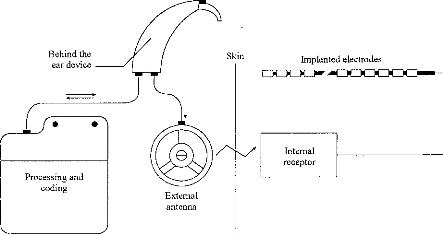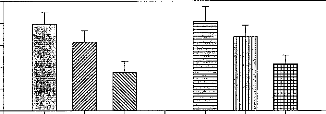Article 6 :
SIMULATION OF AN HEARING AID BASED ON COCHLEAR IMPLANT
CODING
S. Garnier, S. Gallégo, V. Ziempfer, C. Berger-Vachon
Advances in Modeling & Analysis, 1997, 37: 37-44
Dans cet article nous mesurons l'intelligibilité du
signal traité par l'implant et restitué acoustiquement sur un
signal de parole bruité à différents rapports signal sur
bruit (non bruité, S/B -3 dB, S/B +3 dB). Afin d'étudier
l'intérêt de la méthode d'extraction de pics pour
réduire le S/B, les deux modes de l'implant cochléaire sont
testés ('A' et 'N').
Les résultats ne montrent pas de différences
entre les modes 'A' et 'N' sur l'intelligibilité. Plus le bruit est
important plus la reconnaissance phonétique est faible. La
compréhension dans le bruit reste très bonne ; avec un bruit 1.4
fois plus grand en énergie que le signal on obtient encore 35 à
40 % de reconnaissance correcte.
Simulation of an hearing aid based on cochlear implant
coding
Stéphane Garnier 1'2,
Stéphane Gallego 1'3, Véronique Ziempfer
1, Christian Berger-Vachon 1
« Perception and Auditory Mechanisms » Laboratory,
UPRESA CNRS 5020, Pav. U, E. Herriot Hospital, 69437 Lyon Cedex 03, France
2 ENTENDRE Hearing Aids Dispensers Group, GIPA 2, 40
route du Pontel, 78760 JouarsPontchartrain, France
3 MX1VILaboratory, les Mimosas, Quartier Croix Rouge,
06600 Antibes, France.
SUMMARY
Cochlear implant coding strategy has already shown the great
ability of the auditory system to adapt to temporal and spectral
impoverishment. The aim of this study is to simulate the signal processing made
by cochlear implant to evaluate a possible application to conventional hearing
aids. The system which was used to extract stimulations characteristics is the
processor of the MXM DIGISONIC DX10 transcutaneous multichannel cochlear
implant. Reconstruction of the acoustic signal has been performed using
informations given by the implant. Eight normal-hearing subjects participated
to the study. The test consisted in a vocal audiometry with three signal to
noise ratios (silence, -3 dB and 3 dB). Results show that when noise is
present, the processing has a negative effect on the intelligibility. In the
other hand, good results were obtained in silence. They are rather interesting
for a possible application of such a coding to the conventional correction of
severe hearing loss.
KEYWORDS : Hearing aids; Cochlear implant; Simulation
INTRODUCTION
Hearing in noise is the highest source of discomfort for people
with a sensorineural hearing loss. Then, hearing comfort and intelligibility in
noise should be an important aim of hearing
aids. Nowadays, analogic technologies are the most commonly
used, but they cannot implement complex algorithms to reduce interfering noise
before amplification. For example we could mention the adaptive filtering which
adjusts the frequency gain response regarding background noise, or directional
microphones selecting the information at the source. To be implemented in
hearing aids, these techniques meet the limitation of analogic technology.
Apparition of numeric systems, allowing a more powerful signal processing, is
encouraging.
Cochlear implant (CI) coding strategy has already shown the
high ability of the auditory system to adapt to temporal and spectral
impoverishment. The implant used in this study (DIGSONIC DX10 of MXM) extracts
the energy out of 15 frequency bands and transmits an electrical stimulation to
the implanted electrodes along the cochlea. Energy is proportional to the
corresponding frequency band. In general, only the bands of greatest energy are
transmitted.
The aim of this study is to imitate the signal processing
used in cochlear implant in order to judge its possible application to
conventional hearing aids. In order to do so, we evaluated in simulation the
effect of this processing on normal-hearing subjects. Results obtained using
that « smearing » of the signal are presented below.
METHODS
Information coding with a cochlear
implant
Cochlear implant is classically used with post-lingually totally
deaf aduits or with prelingually totally deaf children.
In accordance with the spectral tonotopy of the cochlea, each
electrode of the implant stimulates a specific nerve bundle representing a
frequency bandwidth. But the auditory sensation of implanted patients cannot be
fully compared to a normal one. Practically, electrodes are disposed in the
first round of the cochlea. Then they stimulate mostly the basal part which
corresponds to frequencies ranging from 1 kHz to 16 kHz (Greenwood 1990).
Consequently, there is a transposition of the sensation from low to high
frequencies.
The DIGISONIC DX10 manufactured by the MXM Laboratory is a
transcutaneous, 15- channel cochlear implant. It is composed of two parts
(figure 1), one externat (microphone, digital processor and emitting
antenna)- and the other internai (Receptor and implanted electrodes
which are distributed chirurgically along the cochlea).
Microphone

Figure 1 : Digisonic DX10 block diagram
The digital processing is based on a real time 128-point Fast
Fourier Transformation (FFT). The 64 lines of the spectrum are gathered into 15
adjustable frequency bands. Each band is allocated to an electrode. Encoded
information is sent through the skin to the internai receptor. The internai
decoder transmits to each electrode an intensity which is proportional to the
measured energy in its frequency band. The stimulation rhythm can be fixed (100
to 400 Hz) or proportional to the measured fondamental frequency of the
voice.
Two distinct working modes are available. The « music
» mode allows the stimulation of ail the electrodes. In the « speech
» mode, only 6 bands (at the maximum) which have the highest energy are
transmitted.
Clinical results
h is important to recall clinical results of cochlear implanted
patients. Mean scores of 12 subjects with the Lafon's lists are reported in
figure 2 (Meyer et Al. 1994).
These results support the present study. They show that
cochlear implanted persons (thus having a total cophosis) have better results
than people with profound hearing loss using an acoustical hearing aid.
Figure 2 : Mean results of 12 Digisonic cochlear implanted
subjects (Lafon's lists). In ordinate : 1 month (white), 3 months (gray) and 6
months (black) alter surgery. DIGIGRAM
The DIGIGRAM is a system allowing the real-time recuperation
of pulses information transmitted by the processor. It can be substituted to
the internai part of the implant (Beliaeff et Al. 1994). A serial link with a
Personal Computer (PC) enables the storage of the full information for further
processing.
Signal reconstruction (Simulation)
Data blocs collected by the DIGIGRAM show the energy distributed
by each electrode along the cochlea and during the time (see figure 3).
Processing has been programmed on a PC 486 DX2 66.
For each frequency band (i.e. each electrode), a sinusoid
centered on this band has been synthesized, and the energy measured by the
DIGIGRAM has been applied to this pure tone. The summation of these sinusoids
defines a "window" of the resulting signal (its duration is equal to a frame of
the stimulation). An overlap and add algorithm has been used to insure the
signal continuity.
Signal elementary frame Energy
1
2
3
n
4
Electrode number
12
13
14
15
Figure 3 : Digigram information representation
The restitution has been performed directly from the PC to a
SoundBlaster card connected t a loudspeaker.
Subjects
The study involved 8 normal-hearing subjects (mean age 22,
standard deviation 1.8). All subjects were volunteer students who did not
receive any specific training to the task to be done.
Procedure
Subjects were seated in a soundproof room. The test consisted
in asking them to listen to a word list (Lafon's cochlear lists) which had been
previously treated with the implant processor and with the reconstruction
algorithm.
Lafon's cochlear lists are composed of 17 French words
containing three phonemes (for a total of 51 phonemes). These lists are
commonly used in France for the vocal audiometry.
The number of recognized phonemes gives the intelligibility
score of each subject.
The test had been performed in three situations : silence and
with two masking noises (signal to noise ratio -3 dB and 3 dB) and for the two
modes of the implant (« speech » and « music »). Word lists
were different in each one of the six tests. Silence means that the recordings
have been made in a sound proof room, with a very high signal to noise
ratio.
RESULTS
Figure 4 shows the mean recognition scores calculated over the
subjects. They were obtained for each CI working mode and for each signal to
noise ratio.
It can be seen that the noise had a strong influence on the
recognition percentage.
The good recognition score obtained in silence is"
encouraging. The signal smearing involved by the implant like processing led to
good results on the subjects' performances, results corresponding to those
observed with CI patients.
In addition, this study has been made without any preliminary
training. As it can be seen on figure 2, implanted patients have an important
delay before reaching their optimal score. It can be hoped that some training
could bring better results.

T
100
80
Pourcentage
of recognized 60 phonemes 40
20
Silence S/N=3 dB S/N=-3 dB
Speech Mode Silence S/N=3 dB S/N=-3 dB
Music mode
Figure 4 : Scores obtained for each functioning mode
and
for each signal to noise ratio
DISCUSSION
Through these results, it is seen that there is a strong
information redundancy in speech. Indeed, the drastic selection of the
information introduced by the signal processing did not dramatically lower the
intelligibility of speech in silence.
Let us consider the possible hypothesis that hearing loss
discomfort is partly due to the masking effect induced by the noninformative
part of the signal. This is obvious when a noise is present. This masking
effect is already present among normal hearing subjects. In hearing
impaired people, the broadening of auditory filters greatly
enhances this phenomenon. The larger the auditory filters are, the more
disturbing the noise is.
Results are also somewhat surprising. Only the spectral peaks
of the signal have been kept, and they are above the noise level (when S/N = 3
dB). In this condition, the noise should not have influence the recognition
scores, but this was not the case. Further work is needed to see more deeply
that phenomenon.
h can be imagined that the selective action of our signal
processing (only 6 pure tones are used in speech mode) can bring some help for
peuple with difficulty to separate speech from noise.
CONCLUSION
Used in simulation, the coding strategy of the MXM cochlear
implant did not dramatically lower the hearing performances of normally hearing
subjects in quiet circumstances. This raises hopes for the application in
conventional hearing aids.
Consequently, picking information on the spectrum maxima
appears to be a good way of representation of the acoustic signal. Now, it
needs to be tested with people with a profound hearing loss, in order to bring
a extension of the results obtained with cochlear implanted subjects.
ACKNOWLEDGMENT
This work was supported by a Brant from the ENTENDRE Hearing
Aids Dispenser Group. The authors thank also the French National Scientific
Research Center (CNRS) and the Hospitals of Lyon.
They also acknowledge the help of professors L. Collet and A.
Morgon from the E.N.T. clinic of the Edouard Herriot Hospital of Lyon.
REFERENCES
Beliaeff Michel, Dubus Philippe, Leveau Jean-Marc, Repetto
Jean-Claude, Vincent Philippe. (1994) Sound signal
processing and stimulation coding of the Digisonic DXJO 15-channel cochlear
implant. Advances in Cochlear Implants, edited by I.J. Hochmair-Desoyer
and E.S. Hochmair, Innsbruck University, Austria, 198-203.
Bogli Hans, Dillier Norbert (1991)
Digital speech processor for the nucleus 22-channel cochlear
implant. Annual International Conference- of the IEEE
Engineering in Medicine and Biology Society, Prague, May 18-21, 13 (4),
1887-8.
Greenwood DD (1990) A cochlear
frequency-position fonction for several species-29 years later. J. Acoust.
Soc. Am. 87 (6), 2592-605.
Kompis Martin, Dillier Norbert (1994)
Noise reduction for hearing aids : combining directional
microphones with adaptive beamformer. J. Acoust. Soc. Am. 96 (3),
1910-3.
Meyer B, Jacquier I, Fugain C, Chouard C-H (1994)
Clinical results of the mzdtichannel cochlear implant DIGISONIC.
Advances in Cochlear Implants, edited by I.J. HochmairDesoyer and E.S.
Hochmair, Innsbruck University, Austria, 198-203.
| 


